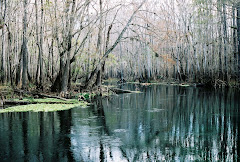
As I was leaving the house yesterday I noticed that the truck of the state alligator trapper was parked by the pond nearest to our house. Apparently someone had lodged a complaint about a nuisance gator and they had come to capture it. I dashed back into the house and grabbed my camera and went down to the pond to observe these guys in action.
They were able to observe a pair of gators in the pond and captured the smaller of the two. The other gator was a bit older and wiser in such matters and scrammed out of the area altogether. The game wardens waited around for it to reappear but finally gave up and carried their lone captive back to the truck.
The really sad part of the story is that once a gator feels comfortable approaching humans it must be destroyed because releasing it elsewhere runs the risk that it would just repeat past behaviors in a new locale. Alligators become habituated to being around humans because people irresponsibly feed them, which is a violation of state law, and this makes them dangerous because they lose their natural fear of humanity. This loss of fear increases encounters and can lead to attacks and serious injuries.
As I walked back to my house I passed the game warden's truck and heard a slithering commotion in the back of it. Much to my dismay I discovered that were three other caged captives awaiting their fate as a pair of shoes or a suitcase. Just another day in the life of the Florida Nuisance Alligator Trapper.

















